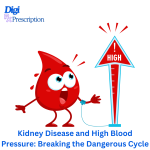
High blood pressure (hypertension) and kidney disease are deeply intertwined, creating a harmful cycle that can lead to heart disease, kidney failure, and even death if left unmanaged. In this post, we’ll explore how these conditions fuel each other, key warning signs, and actionable steps to protect your health.
The Link Between Kidney Disease and High Blood Pressure
How High Blood Pressure Harms Kidneys
Hypertension damages blood vessels in the kidneys, reducing their ability to filter waste and excess fluid.
Over time, this can lead to chronic kidney disease (CKD) or accelerate existing kidney damage.
How Kidney Disease Raises Blood Pressure
Damaged kidneys struggle to regulate sodium and fluid balance, causing blood pressure to spike.
They also produce less renin, a hormone that helps control blood pressure, worsening hypertension.
Fact: Nearly 1 in 3 adults with high blood pressure also has kidney disease, and 50% of CKD cases are linked to hypertension (National Kidney Foundation).
Symptoms to Watch For
Both conditions are “silent killers” with subtle early signs:
Hypertension Symptoms:
Headaches, dizziness, blurred vision, or nosebleeds (in severe cases).
Kidney Disease Symptoms:
Swelling in legs/face, fatigue, foamy urine, frequent nighttime urination, and persistent itching.
Red Flag: If you have hypertension and notice kidney-related symptoms, seek medical care immediately.
5 Steps to Break the Cycle
1. Monitor Your Blood Pressure Regularly
Aim for a target below 130/80 mmHg (guidelines vary; consult your doctor).
Use a home blood pressure cuff for daily tracking.
2. Adopt a Kidney-Friendly Diet
Reduce Sodium: Avoid processed foods, canned soups, and salty snacks.
Limit Protein: Excess protein strains kidneys; opt for plant-based sources like beans (in moderation).
Control Potassium/Phosphorus: Avoid bananas, potatoes, and dairy if advised by your renal dietitian.
3. Stay Active
Exercise lowers blood pressure and improves kidney health. Aim for 30 minutes of walking, swimming, or yoga daily.
4. Take Prescribed Medications
ACE Inhibitors (e.g., lisinopril) or ARBs (e.g., losartan): These protect kidney function and lower blood pressure.
Avoid NSAIDs (ibuprofen, naproxen), which can harm kidneys.
5. Manage Underlying Conditions
Control diabetes, obesity, or high cholesterol—all risk factors for kidney disease and hypertension.
When to Get Tested
Blood Pressure: Check at least annually (more often if readings are high).
Kidney Function Tests:
eGFR (estimated glomerular filtration rate): Measures kidney filtering ability.
Urine Albumin Test: Detects protein in urine, an early sign of kidney damage.
Who’s at Risk?
Adults over 60
Those with diabetes or a family history of kidney disease
African Americans, Hispanics, and Indigenous populations
Prevention Tips
Quit smoking (it damages blood vessels).
Limit alcohol to 1 drink/day for women.
Stay hydrated with water (unless fluid-restricted).
Real-Life Impact: A Patient’s Story
Maria, 58, struggled with uncontrolled hypertension for years. After being diagnosed with Stage 3 CKD, she adopted a low-sodium diet, started walking daily, and took her ARB medication religiously. Within 6 months, her blood pressure stabilized, and her kidney function improved. “It’s never too late to take control,” she says.
Key Takeaways
Hypertension and kidney disease worsen each other, but early intervention can halt progression.
Lifestyle changes and medication are critical for managing both conditions.
Regular screenings save lives—don’t wait for symptoms to appear.
References
National Kidney Foundation: Hypertension and CKD
American Heart Association: Kidney Disease & High Blood Pressure
Mayo Clinic: Kidney-Friendly Diet
Call to Action:
If you have high blood pressure or a family history of kidney disease, schedule a kidney function test today. Share this post to spread awareness—knowledge is power in breaking this dangerous cycle! ????
